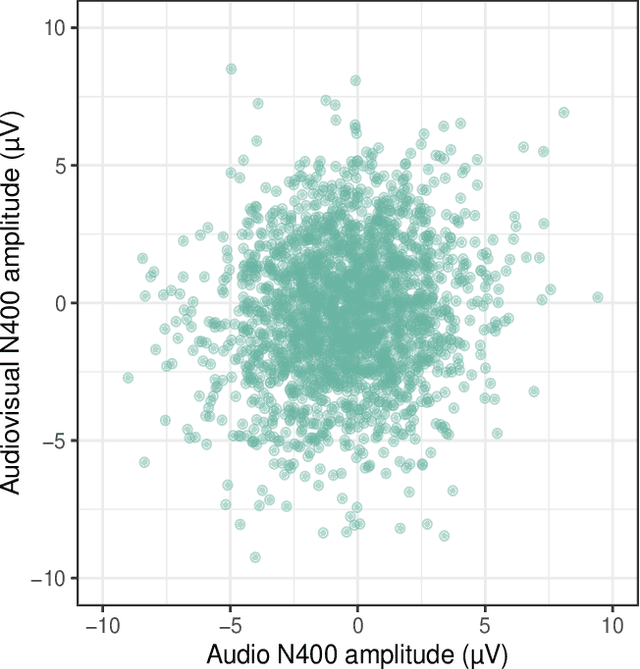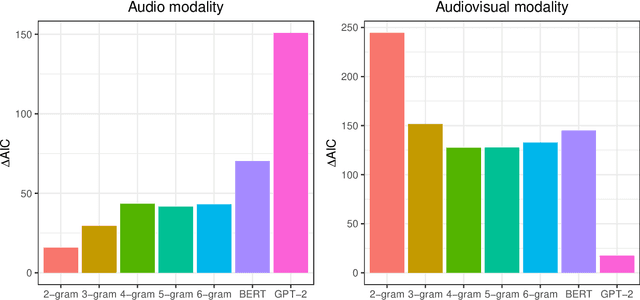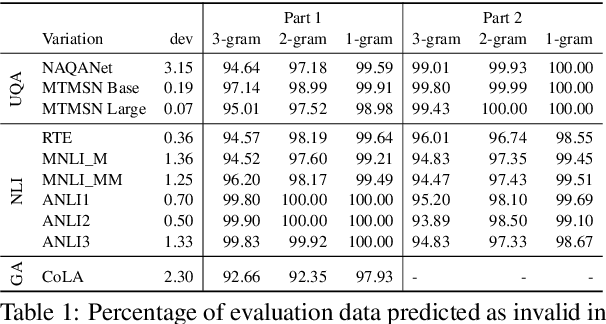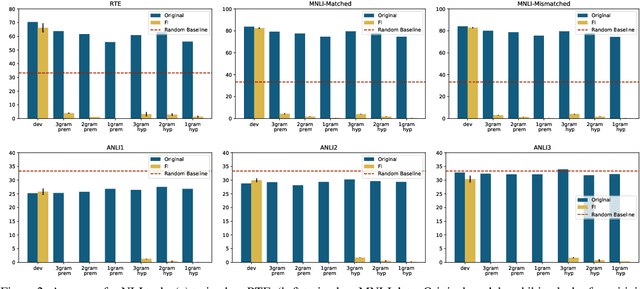Pranava Madhyastha
Noise or Nuance: An Investigation Into Useful Information and Filtering For LLM Driven AKBC
Sep 10, 2025Abstract:RAG and fine-tuning are prevalent strategies for improving the quality of LLM outputs. However, in constrained situations, such as that of the 2025 LM-KBC challenge, such techniques are restricted. In this work we investigate three facets of the triple completion task: generation, quality assurance, and LLM response parsing. Our work finds that in this constrained setting: additional information improves generation quality, LLMs can be effective at filtering poor quality triples, and the tradeoff between flexibility and consistency with LLM response parsing is setting dependent.
Chart Question Answering from Real-World Analytical Narratives
Jul 02, 2025Abstract:We present a new dataset for chart question answering (CQA) constructed from visualization notebooks. The dataset features real-world, multi-view charts paired with natural language questions grounded in analytical narratives. Unlike prior benchmarks, our data reflects ecologically valid reasoning workflows. Benchmarking state-of-the-art multimodal large language models reveals a significant performance gap, with GPT-4.1 achieving an accuracy of 69.3%, underscoring the challenges posed by this more authentic CQA setting.
IYKYK: Using language models to decode extremist cryptolects
Jun 05, 2025Abstract:Extremist groups develop complex in-group language, also referred to as cryptolects, to exclude or mislead outsiders. We investigate the ability of current language technologies to detect and interpret the cryptolects of two online extremist platforms. Evaluating eight models across six tasks, our results indicate that general purpose LLMs cannot consistently detect or decode extremist language. However, performance can be significantly improved by domain adaptation and specialised prompting techniques. These results provide important insights to inform the development and deployment of automated moderation technologies. We further develop and release novel labelled and unlabelled datasets, including 19.4M posts from extremist platforms and lexicons validated by human experts.
An Empirical Study of Conformal Prediction in LLM with ASP Scaffolds for Robust Reasoning
Mar 07, 2025Abstract:In this paper, we examine the use of Conformal Language Modelling (CLM) alongside Answer Set Programming (ASP) to enhance the performance of standard open-weight LLMs on complex multi-step reasoning tasks. Using the StepGame dataset, which requires spatial reasoning, we apply CLM to generate sets of ASP programs from an LLM, providing statistical guarantees on the correctness of the outputs. Experimental results show that CLM significantly outperforms baseline models that use standard sampling methods, achieving substantial accuracy improvements across different levels of reasoning complexity. Additionally, the LLM-as-Judge metric enhances CLM's performance, especially in assessing structurally and logically correct ASP outputs. However, calibrating CLM with diverse calibration sets did not improve generalizability for tasks requiring much longer reasoning steps, indicating limitations in handling more complex tasks.
$\texttt{SEM-CTRL}$: Semantically Controlled Decoding
Mar 03, 2025Abstract:Ensuring both syntactic and semantic correctness in Large Language Model (LLM) outputs remains a significant challenge, despite being critical for real-world deployment. In this paper, we introduce $\texttt{SEM-CTRL}$, a unified approach that enforces rich context-sensitive constraints and task- and instance-specific semantics directly on an LLM decoder. Our approach integrates token-level MCTS, which is guided by specific syntactic and semantic constraints. The constraints over the desired outputs are expressed using Answer Set Grammars -- a logic-based formalism that generalizes context-sensitive grammars while incorporating background knowledge to represent task-specific semantics. We show that our approach guarantees correct completions for any off-the-shelf LLM without the need for fine-tuning. We evaluate $\texttt{SEM-CTRL}$ on a range of tasks, including synthetic grammar synthesis, combinatorial reasoning, and planning. Our results demonstrate that $\texttt{SEM-CTRL}$ allows small pre-trained LLMs to efficiently outperform larger variants and state-of-the-art reasoning models (e.g., o1-preview) while simultaneously guaranteeing solution correctness.
LLM-Assisted Visual Analytics: Opportunities and Challenges
Sep 04, 2024Abstract:We explore the integration of large language models (LLMs) into visual analytics (VA) systems to transform their capabilities through intuitive natural language interactions. We survey current research directions in this emerging field, examining how LLMs are integrated into data management, language interaction, visualisation generation, and language generation processes. We highlight the new possibilities that LLMs bring to VA, especially how they can change VA processes beyond the usual use cases. We especially highlight building new visualisation-language models, allowing access of a breadth of domain knowledge, multimodal interaction, and opportunities with guidance. Finally, we carefully consider the prominent challenges of using current LLMs in VA tasks. Our discussions in this paper aim to guide future researchers working on LLM-assisted VA systems and help them navigate common obstacles when developing these systems.
Are words equally surprising in audio and audio-visual comprehension?
Jul 14, 2023

Abstract:We report a controlled study investigating the effect of visual information (i.e., seeing the speaker) on spoken language comprehension. We compare the ERP signature (N400) associated with each word in audio-only and audio-visual presentations of the same verbal stimuli. We assess the extent to which surprisal measures (which quantify the predictability of words in their lexical context) are generated on the basis of different types of language models (specifically n-gram and Transformer models) that predict N400 responses for each word. Our results indicate that cognitive effort differs significantly between multimodal and unimodal settings. In addition, our findings suggest that while Transformer-based models, which have access to a larger lexical context, provide a better fit in the audio-only setting, 2-gram language models are more effective in the multimodal setting. This highlights the significant impact of local lexical context on cognitive processing in a multimodal environment.
Towards Robust Aspect-based Sentiment Analysis through Non-counterfactual Augmentations
Jun 24, 2023Abstract:While state-of-the-art NLP models have demonstrated excellent performance for aspect based sentiment analysis (ABSA), substantial evidence has been presented on their lack of robustness. This is especially manifested as significant degradation in performance when faced with out-of-distribution data. Recent solutions that rely on counterfactually augmented datasets show promising results, but they are inherently limited because of the lack of access to explicit causal structure. In this paper, we present an alternative approach that relies on non-counterfactual data augmentation. Our proposal instead relies on using noisy, cost-efficient data augmentations that preserve semantics associated with the target aspect. Our approach then relies on modelling invariances between different versions of the data to improve robustness. A comprehensive suite of experiments shows that our proposal significantly improves upon strong pre-trained baselines on both standard and robustness-specific datasets. Our approach further establishes a new state-of-the-art on the ABSA robustness benchmark and transfers well across domains.
Towards preserving word order importance through Forced Invalidation
Apr 11, 2023



Abstract:Large pre-trained language models such as BERT have been widely used as a framework for natural language understanding (NLU) tasks. However, recent findings have revealed that pre-trained language models are insensitive to word order. The performance on NLU tasks remains unchanged even after randomly permuting the word of a sentence, where crucial syntactic information is destroyed. To help preserve the importance of word order, we propose a simple approach called Forced Invalidation (FI): forcing the model to identify permuted sequences as invalid samples. We perform an extensive evaluation of our approach on various English NLU and QA based tasks over BERT-based and attention-based models over word embeddings. Our experiments demonstrate that Forced Invalidation significantly improves the sensitivity of the models to word order.
Theoretical Conditions and Empirical Failure of Bracket Counting on Long Sequences with Linear Recurrent Networks
Apr 07, 2023


Abstract:Previous work has established that RNNs with an unbounded activation function have the capacity to count exactly. However, it has also been shown that RNNs are challenging to train effectively and generally do not learn exact counting behaviour. In this paper, we focus on this problem by studying the simplest possible RNN, a linear single-cell network. We conduct a theoretical analysis of linear RNNs and identify conditions for the models to exhibit exact counting behaviour. We provide a formal proof that these conditions are necessary and sufficient. We also conduct an empirical analysis using tasks involving a Dyck-1-like Balanced Bracket language under two different settings. We observe that linear RNNs generally do not meet the necessary and sufficient conditions for counting behaviour when trained with the standard approach. We investigate how varying the length of training sequences and utilising different target classes impacts model behaviour during training and the ability of linear RNN models to effectively approximate the indicator conditions.
 Add to Chrome
Add to Chrome Add to Firefox
Add to Firefox Add to Edge
Add to Edge